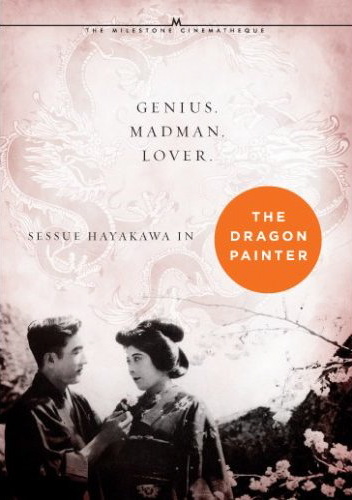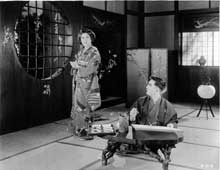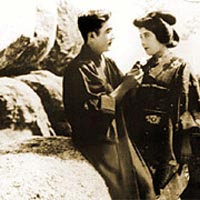| Release List | Reviews | Price Search | Shop | Newsletter | Forum | DVD Giveaways | Blu-Ray/ HD DVD | Advertise |
| Reviews & Columns |
|
Reviews DVD TV on DVD Blu-ray International DVDs Theatrical Reviews by Studio Video Games Features Collector Series DVDs Easter Egg Database Interviews DVD Talk TV DVD Talk Radio Feature Articles Columns Anime Talk DVD Savant HD Talk Horror DVDs Silent DVD
|
DVD Talk Forum |
|
|
| Resources |
|
DVD Price Search Customer Service #'s RCE Info Links |
|
Columns
|
 |
The Dragon Painter |

|
The Dragon Painter Milestone/New Yorker 1919 / B&W / 1:33 flat full frame / 53 min. / Street Date March 18, 2008 / 29.95 Starring Sessue Hayakawa, Tsuru Aoki New Music Mark Izu Written by Richard Schayer from a novel by Mary McNeil Fenollosa Produced by Sessue Hayakawa Directed by William Worthington |
Before the major studios dominated the field, Hollywood moviemaking was a wildcat business. Dozens of independent film companies turned out popular silent pictures, most of which are now lost. Successful actors founded their own mini-studios, hoping to get a piece of the real profits. Under their Haworth banner matinee idol Sessue Hayakawa and his director William Worthington produced a long string of romantic pictures, often co-starring Hayakawa's wife, Tsuru Aoki. Eastman House, Milestone and New Yorker bring us 1919's The Dragon Painter, an American-made film that exhibits a Japanese sensibility.

Most of us know Sessue Hayakawa through a single movie made forty years later, David Lean's The Bridge on the River Kwai. Lean hired the Japanese actor after seeing him in Samuel Fuller's House of Bamboo, not realizing that Hayakawa was not fluent in English. It's quite a shock to see the facial features of Kwai's stout Colonel Saito in this striking young man, who is easily as handsome as Rudolph Valentino. In the early 1920s Hayakawa's fan following was the equal of any matinee idol in Hollywood. 1
The Dragon Painter has the simplicity of a folk tale. Tatsu possesses both natural talent and a pure heart. Romantic yearning feeds his artistic drive, but that urge vanishes when Tatsu marries. As with the story of Samson and Delilah, when Tatsu falls under the erotic influence of Ume Ko, his 'magic' disappears. Love can be the enemy of Art, and vice-versa: to recover his will to paint, Tatsu must strike a balance in his life. Profundity-in-simplicity is often cited as an attribute of Japanese art, which makes The Dragon Painter an American picture with a Japanese flavor.
'Nature man' Tatsu sketches madly in a tall forest that might be Yosemite National Park. If Hayakawa distributed his pictures in Japan, the locals must have marveled at the gigantic Redwoods beyond his art pad. The Sierra Club probably wouldn't appreciate Tatsu's habit of tossing away his drawings like an artistic litterbug. The film employs a number of clever matte paintings, using artwork barely more detailed than finger paint daubings. They're crude, but they lend the film a unique pictorial quality.

Hayakawa's gestures as the 'exuberant, emotional' Tatsu are overstated, but most of the film's acting is naturalistic, like something from a European silent. Predictably, the responsibility for Tatsu's morale falls to the woman in the story. It's Tatsu's problem, but dutiful wife Ume Ko makes the sacrifice.
Ume Ko is introduced to Tatsu in an enchanting theatrical context, revealed behind a paper screen. At first we can't tell whether she is indeed a fantasy princess, or if Tatsu is a naïve simpleton struck dumb by the first painted geisha he sees. A cruel 'Twilight Zone'- inflected version of The Dragon Painter would have Tatsu marry Ume Ko, only to be equally enchanted by the second civilized beauty he meets.
Milestone and New Yorker's DVD of The Dragon Painter presents a good print recovered in France and restored by The Eastman House. The nearly 90 year-old film is in almost perfect condition, and we can see plenty of texture in the handsome exterior photography. Mark Izu's score is handsomely produced, and adds greatly to our enjoyment of the film.
The main extra is a second, hour-long feature, The Wrath of the Gods. From 1914, it's one of Hayakawa's first films. The image quality isn't as good as Dragon, but it appears to be intact. Written by Thomas Ince, this one's more of what we'd expect from an American production of the time. In Japan, a 'heathen' holy man denounces a fisherman's daughter (Aoki) as a demon. When she falls in love with and marries a marooned American sailor (future director Frank Borzage), the enraged locals kill her father (Hayakawa), who has converted to Christianity. Although an erupting volcano wipes out the community, the lovers are saved by Christian faith. Inspired by a 1914 eruption on the Japanese island of Sakara-jima, parts of The Wrath of the Gods were filmed on the beach in Santa Monica!
Milestone's disc includes an interesting image gallery and a five-minute comedy skit in which Hayakawa plays straight man to Fatty Arbuckle and Charles Murray. DVD-ROM extras thoroughly document both features. Besides Milestone's Press Kit, the text features include Brian Taves' essay on Hollywood's First Asian Cycle, the entire novel The Dragon Painter and the original shooting script for The Wrath of the Gods.
One amusing DVD-ROM extra is titled How to Build Your Own Volcano.
On a scale of Excellent, Good, Fair, and Poor,
The Dragon Painter rates:
Movie: Excellent
Video: Very Good
Sound: Excellent
Supplements: second Feature The Wrath of the Gods (1914), comedy short, image gallery, DVD-ROM extras.
Packaging: Keep case
Reviewed: February 23, 2008
Footnote:
1. This happened more often than one would imagine. As the twentieth century was the first completely documented on motion-picture film, humans were able to see movie stars 'age' year by year. A viewer familiar with the elderly Neil Hamilton, 'Commissioner Gordon' on the Batman TV show, can be shocked to discover him as a handsome leading man back in the 20's and 30's. Virginia Christine, the 'Folger's Lady' of 1960s TV commercials, was a comely ingenue only twenty years earlier. More in line with Sessue Hayakawa is the Mexican-American actor Antonio Moreno. Those who know Moreno remember him as the chivalrous Mexican Indian trader in The Searchers, or the old professor in The Creature from the Black Lagoon. Back in the twenties, Moreno was yet another popular matinee idol, with dark eyes and Valentino-like bedroom manners.
Return
Reviews on the Savant main site have additional credits information and are more likely to be updated and annotated with reader input and graphics.
Review Staff | About DVD Talk | Newsletter Subscribe | Join DVD Talk Forum
Copyright © 1999-2007 DVDTalk.com All rights reserved | Privacy Policy | Terms of Use
|
| Release List | Reviews | Price Search | Shop | SUBSCRIBE | Forum | DVD Giveaways | Blu-Ray/ HD DVD | Advertise |





